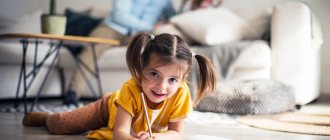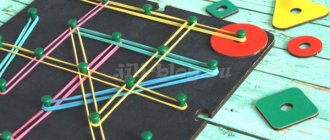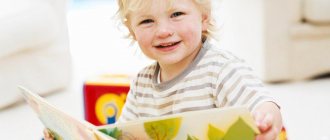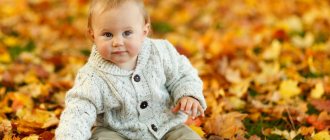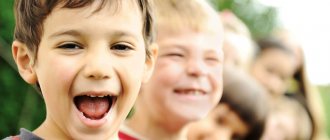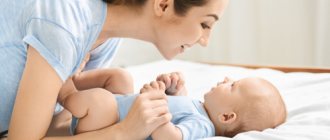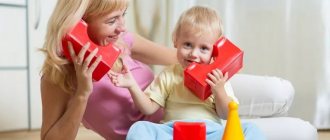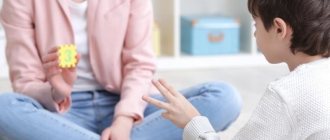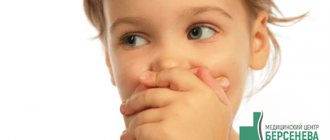When a child turns 3 years old, both parents and the baby themselves face tremendous changes. This is the famous crisis of three years, and a possible acquaintance with kindergarten, and for the first time truly meaningful behavior.
The pace of development of children is individual. Some three-year-olds already speak fluently, show interest in learning and strive for complete independence. Other children at the same age do not develop as actively, but this is not a deviation at all. However, there are general standards for what a 3-year-old child should be able to do. And if you are worried about whether your baby is developing in a timely manner, follow these standards and, most likely, you will make sure that everything is fine with your child!
Features of development of children 3 years old
Three years is an important age in the life of a baby. At this time, great changes occur in his psyche. A calm, obedient child suddenly becomes capricious and uncontrollable, and the parents are perplexed: what happened?
There's no need to worry. In psychology, there is such a thing as the three-year crisis. It is he who provokes such changes in the behavior of children. The first signs of an emerging crisis become noticeable as early as two years of age. By the end of the third year of life, the crisis reaches its peak.
The crisis of three years can be recognized by the following signs:
- Negativism. The child refuses all requests and suggestions from the parents. This greatly irritates adults, but you need to understand that in this way the baby learns to recognize himself as a separate person.
- Stubbornness. The baby becomes very stubborn. He demands that his wishes be fulfilled immediately, and if this does not happen, he throws a tantrum.
- The desire for independence. The child tries to do everything himself - dress, wash, brush his teeth, etc. Adults’ attempts to help him are categorically rejected.
- Conflict. The child becomes conflicted: he contradicts his parents, swears, ignores their requests, and protests against the established rules.
- Jealousy. The baby begins to be jealous of his parents for his brothers or sisters. If there are none, he may begin to be jealous of mom and dad.
These changes in behavior are age-related features that go away over time.
When should you sound the alarm?
Although completely healthy children at 3 years old may not be able to do everything that is prescribed by the norms, there are a number of signs that indicate a child’s developmental delay.
So, when is a trip to the doctor inevitable?
- The child mumbles, “rumbles,” “swallows” endings and entire parts of words, his speech is slurred and incomprehensible.
- The child has increased salivation.
- The baby cannot dress himself, does not hold a spoon, and is unable to relieve himself.
- The baby moves poorly, cannot jump, and does not throw the ball.
- The child cannot form a simple logical chain, does not know basic concepts, and does not know how to put together a pyramid of cubes.
- The child does not make contact with other children, does not seek their company, and always and everywhere wants to be close to the parent.
- The baby does not recognize family members, does not make eye contact, and throws tantrums for any reason.
These and other signs indicate that the baby has certain problems. Only a doctor can assess the situation and make a final verdict, so do not delay the consultation.
Intellectual development
At this age, visual-effective thinking is transformed into visual-figurative thinking. If previously the baby learned about the world through direct contact with various objects, now he can already operate with images of these objects stored in his memory.
At three years old, a child should be able to:
- understand simple cause-and-effect relationships;
- demonstrate first action planning skills;
- compare objects by size, shape, color;
- put together simple puzzles from four large parts;
- know the basic colors and be able to name them;
- know the names of surrounding objects (dishes, furniture, products), animals;
- know the names of basic geometric shapes.
An important feature of this age is that a growing baby can think and reason about objects that are not in the field of view. This is an important step towards further development of thinking.
How to help a child develop correctly?
It is possible and necessary to help a three-year-old child develop - despite the desire for independence, children at this age willingly accept help from adults. Especially if this help is presented in the form of a game.
How to help three-year-old children develop important skills and abilities in accordance with the recommendations of teachers:
- Ask your child to tell you in detail how his day went. This technique trains memory better than special educational games.
- Resist in offering help. The less outside help, the faster the three-year-old will learn independence.
- Use your fingers to learn to count within five, and a little later - up to ten.
- In toys, give preference to pyramids, cubes, puzzles - they perfectly develop the skills of attentiveness, perseverance and spatial thinking.
- If there are no health contraindications, introduce your son or daughter to sports. Swimming is especially suitable - a universal way to maintain health, form beautiful posture, and strengthen all muscle groups.
Do not worry about the development and safety of your child, especially when he is away from you or home. Three years and going to kindergarten is a great reason to buy your baby his first GPS watch. With them and the “Where are my children” application, you will always know where your child is and what is happening around him.
Games
Play is the most important activity for a three-year-old child. At this age, the child enjoys the process exclusively, without setting a goal to learn new things. But parents can offer their son or daughter games that will help children's development.
Examples of educational games for three years:
- Games with water. Kids love to be in contact with water - help your little ones create their own water world. You can include bowls, glasses, a colander, and a spray bottle in the game and show how to play with water using these items. Water games develop imagination, coordination, and fine motor skills.
- Finger games. Classes with elements of finger gymnastics, like no other, develop fine motor skills.
- Modeling from plasticine or salt dough. Modeling helps develop creativity and fine motor skills.
- Games with cubes of different shapes and sizes. While building with cubes, reaction speed develops, the baby remembers colors and shapes, learns to compare objects and masters counting.
- Puzzles and mosaics. Starting with simple options, move on to more complex ones with more details. Puzzles and mosaics develop the ability to concentrate, develop imagination and fine motor skills.
Another feature of this period of child development is the three-year crisis. It is not simple. But you need to survive it, showing patience and helping the baby develop. And when the difficulties are left behind, the child will become an excellent conversationalist, play partner and best friend for his parents!
Speech development
The speech of a three-year-old is very different from the speech of a two-year-old baby. At this age, the child already has a fairly large vocabulary - from 1000 words. The baby can reason and make simple conclusions about people, objects and phenomena.
Children actively remember new words, play with them (change pronunciation, rhyme, come up with sound combinations). Long, complex words are still difficult for babies to pronounce, so they mutilate them.
A 3 year old child should be able to:
- tell how his day went;
- use sentences of 3–5 words or more in speech;
- describe the picture;
- memorize poems and songs;
- name not only the object itself, but also its details (handle of a cup, nose of a dog);
- establish semantic connections between objects;
- ask and answer questions;
- Use polite words (“thank you”, “please”).
Three-year-olds do not yet have very well developed speech. They pronounce hissing and sonorant sounds poorly. They construct sentences incorrectly and lose the endings of words. All this is the norm of development. With age, problems will be eliminated.
I. A. Galkina (Ph.D.)
The age from three to five years is called middle preschool. According to L.S. Vygotsky, during this period children develop completely new relationships between thinking and action, an internal plan of action appears that determines meaningful behavior. Let us consider the age-related features of the development of a child from three to five years old. Their knowledge will help parents not to miss important milestones in the development of their children’s personalities, to notice possible difficulties in time and to correct them.
PHYSICAL DEVELOPMENT
- Reaction speed, coordination and speed of movements are noticeably improved, agility and flexibility appear. Now children become good partners in outdoor games. Their gross and fine motor skills improve.
- The proportions of their body change. Now they are approaching the proportions of an adult’s body, the center of gravity is shifting downward.
- Weight increases due to the growth of bone and muscle tissue. Moreover, boys have more muscle tissue, and girls have more fat. An increase in fat mass occurs due to an increase in volume, not the number of fat cells. At this age, the proportionality of the increase in height and weight is important. If you suddenly notice that the weight data has a clear tendency to overtake the height measurement data, it means that the child is becoming overweight. At an early age, it is important to instill in your child a culture of nutrition so as not to increase fat potential.
- The cartilage gradually becomes hard. The correct formation of the skeletal system largely depends on the quality of nutrition. The child’s diet must contain dairy products, fish, meat, and a sufficient amount of vitamins and minerals.
- All internal organs increase in size, their functions improve, approaching adult norms and proportions.
- The nervous system is also improved. The number of nerve cells increases, the number of connections between them becomes more complex and expands.
- By the age of four, a child should already have a full set of baby teeth. If there are less than twenty of them, then you should seek advice from your local pediatrician or dentist.
MOTOR SKILLS
Three years . The child’s motor skills are enriched: he runs confidently, speeds up and slows down, changes direction, can catch a ball and maintain balance, climbs and descends stairs well, and rides a tricycle. At this age, the baby is able to dress and undress independently, knows how to fasten and unbutton buttons, and put on Velcro shoes. At three years old, a child is already well oriented in space and can easily find the object he needs or complete some task of finding a toy. He also has good hand-eye coordination. He already knows how to use scissors, eat on his own, and drink from a cup.
Four years . Motor activity improves: the child can stand and jump on one leg, walk backwards, jump to the side, forward and backward, alternate running with jumping, jump over low obstacles, march to the beat of the music. Also during this period, a preference for the right / left hand is clearly formed.
Five years . Control over body movements is noticeably improved. All the skills that the child acquired before this age are improved. The space for activities is expanding. At this age, the baby is good at catching a ball with both hands, riding a two-wheeled bicycle, rollerblading, jumping rope, deftly overcoming obstacles, walking on a log, and doing simple dance movements.
MENTAL DEVELOPMENT
The age from three to five years is the most important stage in the development of a child. This period of development is characterized by rapid assimilation of information, so parents should take care of organizing exciting activities with their baby.
At the age of three, a child interacts with the world based only on acquired knowledge. He remembers what happened to him in the past and, based on past experience, makes decisions, confirming old ones or acquiring new skills. The child’s memory in this period of development is involuntary: memorizing information and imprinting images occur by themselves. Children easily remember poems, fairy tales, dialogues from films, and empathize with characters from books and films. By the age of five, memory and attention develop significantly: the child remembers up to 5 words at the request of an adult; carries out instructions consisting of 2-3 consecutive actions. Attention becomes voluntary - a child of four or five years old, if he is asked to constantly say out loud what he has in his field of attention, he will be able to hold it for a long time. The stability of attention increases when looking at attractive objects, listening to fairy tales, and performing intellectually significant actions (puzzle games, riddles).
By the age of four to five, mathematical concepts and numeracy skills are developed. Children use the words “many” and “one” in their speech; name geometric shapes and shapes, learn to identify geometric shapes in surrounding objects. They know and name the seasons and parts of the day. There are right and left hands.
The child’s imagination improves; by the age of four or five, the imagination is so developed that with its help the child can create a simple program of actions in his mind. He gradually learns to replace real objects and situations in his imagination with imaginary ones, this ability especially develops by the age of six or seven.
From four to five years old, children begin to think in images. The child easily remembers, reproduces the information received and actively expands his knowledge about the world around him. This leap in a child’s development occurs due to the development of speech and creative thinking.
SPEECH DEVELOPMENT
At the age of three to five years, active development of speech continues: the vocabulary expands significantly, the child begins to use a variety of nouns and verbs, names the location of objects, and characterizes the emotional states of people. The use of prepositions is expanding, imperative forms of verbs are being used, and sentences are becoming complex. The child is able to retell a short fairy tale, compose a story based on a picture, dialogue speech improves: he maintains a conversation, asks questions and answers them correctly. In general, speech becomes more expressive, contextual, i.e. the child is able to describe a situation in such a way that it is understandable without directly perceiving this situation. The period of four to five years is the peak of the sensitive period of speech development, and provided that the pronunciation of the native language is formed and there are no speech therapy problems, the child can be recommended to begin learning a foreign language.
Normally, a four to five year old child should speak clearly and pronounce all sounds correctly. If a child has difficulties with pronunciation, then you should seek help from a speech therapist. Speech disorders can also be a consequence of hearing impairment. There is a law: as a child hears, so speaks. If your child leaves out some sounds, such as hissing sounds, he may not hear them.
In order to develop your child’s speech more intensively, you need to talk to him more often. And it is important that contact be mutual as often as possible, that is, in the form of dialogue. Parents should not limit themselves to the simplest topics; they can already discuss cartoons and books they have read, relationships with peers and adults.
PERSONAL DEVELOPMENT
The age from three to five years is the most important stage in the development of a child as an individual. At this age, long-term memory is formed. The baby already perceives himself as a separate, unique person, and feelings and emotions form childhood memories and his own unique experience. At this age, the child begins to develop and actively develop character traits such as self-esteem, self-worth, and a sense of dignity.
Imitation remains the main mechanism of personality development. The child is guided by the assessments of adults. Knowledge about oneself becomes more stable, self-esteem begins to form. A child of four to five years old evaluates himself more realistically than at the age of three; he reacts to the praise of adults, correlating his successes with it. An important factor in the development of a child’s personality is the group of peers; the child compares himself with other children, they act as a mirror for him - a peer personifies realistically possible achievements in various types of practical activities, helps to determine his own qualities.
At this age, the child does not yet appreciate the complexity of the task facing him; it is important to him that he coped with it and was praised, but what matters is not so much one-time success as the sustainability of success. By correlating his results with the results of other children, the child learns to correctly assess his capabilities. He develops a level of aspirations and develops an internal position.
After three years, the child begins to see himself from the outside and realize his gender identity. This also needs to be taken into account by parents in order to instill the necessary female and male behavior patterns in a timely manner.
GAMES AND TOYS
Play for a child is a leading activity. From the outside it may seem that the child is having fun while playing, but in fact he is doing important work. In the game, children realize their desire for independence, learn patience, perseverance, communicate with peers, control their behavior, and also develop will, imagination, thinking and moral attitudes.
In games, children already adhere to certain rules and strictly control them, think through the plot of the game in advance and divide roles among themselves. Role-playing play at this age is very important, but the child must be able to play not only in company, but also alone - when only his imagination is involved. A child who plays by himself is more independent of the situation; such a child can be left alone for a while, and he will not experience feelings of anxiety. You can gradually teach your child to play independently. You start a game with him, engage him, then leave the room for a few minutes. An enthusiastic child, by inertia, continues to play alone and gets used to the fact that the constant presence of an adult is not necessary.
In order to develop various aspects of a child’s intelligence, it is necessary that the toys be different: toys for intelligence (simple puzzles), toys that develop spatial thinking (constructors, sets of cubes), toys that develop creative thinking (mosaics, kaleidoscope), etc. Notice with what pleasure your baby plays in the sandbox, what intricate figures he creates from raw sand. At home, such a sandbox can be successfully replaced by plasticine and clay. More often engage in modeling, drawing, appliqué, etc. with your child. These activities develop the child's creative thinking and creative abilities.
Middle preschool age is an important stage of child development. He masters a lot of new knowledge, skills and abilities that are extremely important for his further full development. The task of parents is to expand the child’s horizons as much as possible. This age can be called the age of “intellectual hunger” - the baby wants to know about everything and asks a lot of questions, sometimes very unexpected and difficult. It is very important to answer them and form the right values in the child. By doing this in a playful way during this period, you can lay the foundations for moral development, which will certainly bear fruit in later years.
In order for the development of a child aged 3 to 5 years to be successful, it is important not only for the parents to properly raise children, but it is also advisable for children to attend special classes conducted by experienced psychologists. Our children's development center has an additional general developmental program “Psychological developmental activities”, which is designed for children of this age. We will talk about this program in the second part of our article.
Neuropsychic development
During this period, the performance of the nervous system increases. The baby can already restrain his emotions, for example, not cry when he is hurt or offended.
His ability to concentrate increases. Now he can do something for 10–15 minutes without being distracted by anything else. Distracting a crying three-year-old by redirecting his attention is not so easy, because he has already concentrated on his negative emotions.
At this age, the child cannot yet properly manage his behavior. The three-year crisis mentioned above also adds to the difficulties. The baby's inner world is full of contradictions that result in whims and hysterics.
Emotions and social adaptation
Perhaps, until the age of three, the child did not particularly need communication with other children. He was quite happy with the company of his parents and other close relatives. Now the baby consciously strives to join the company of his peers. He is interested in playing in the yard and on the playground, and in kindergarten he is no longer naughty or cries because of separation from his mother.
It is very important not to interfere with the child’s communication with other children. In this way he adapts to life in society, and this is very important in the modern world.
At 3 years old, a child, without noticing it, is actively forming his own personality and acquiring important social skills.
- He is aware of his Self, understands the meaning of the concept “mine”.
- Imitates people he knows.
- He is drawn to other children, easily meets and makes friends, but does not yet show interest in group games.
- He distinguishes between relatives and loved ones; he assigned a certain place to each of them in his understanding.
- Consciously expresses emotions.
- It is easier to cope with your emotions and learns to suppress them if necessary.
- He fantasizes and invents - for example, he may well invent a monster under the bed and be frightened by his fantasy.
Useful: What should a developed child be able to do at 10 months?
Don’t worry too much if during this period your baby invents an imaginary friend. This is quite normal, but if it worries you too much, you can consult a child psychologist.
Also, don't worry if your baby moves away a little from you. At three years old, almost all children begin to feel like an individual and a person separate from their mother.
Take your baby for walks on playgrounds and other places where children gather more often. Let the baby be in the company of peers and learn to communicate.
If your child has a conflict with a new friend, do not rush to intervene. Let the child try to solve his problem himself. Later, explain to him how to act correctly in such situations, and give reasons why he should do it this way and not otherwise.
Math skills
At 3 years old, children already have some mathematical skills. They must know and be able to:
- count to five forward and backward;
- show the number on your fingers;
- know what numbers from 1 to 5 look like;
- compare the number of objects in different groups using the concepts “more”, “less”, “same”;
- know and be able to draw basic geometric shapes (circle, square, triangle, oval, rectangle);
- recognize the outlines of geometric shapes in various objects (a clock is a circle, a TV is a rectangle).
Some kids already know all the numbers from 0 to 10 and can write them. This is a good help for future preparation for school.
Physical development
A 3-year-old child controls his body much more confidently than a 2-year-old. At this age, children can:
- jump on two legs in height and length;
- stand on one leg without falling;
- jump over obstacles;
- run quickly and confidently;
- climb the wall bars;
- ride a tricycle or scooter;
- ride downhill;
- kick the ball.
Kids love physical activity and quickly develop their abilities.
Crisis of three years
The three-year crisis is considered the most turbulent in a child’s development, and it is a serious obstacle to regular developmental activities. Negativism, hysterics, stubbornness, ignoring requests, jealousy - you can encounter all this at any time. What to do in this case?
- Change your tactics and ignore the hysteria.
- Give your child more time to recover.
- Provide choice, or the illusion of it.
- Instead of forcing your child, offer help.
- Don't criticize or scold.
If you feel that you cannot cope with yourself and your child, seek the help of child psychologists and early development teachers. Most likely, in an unfamiliar environment the child will begin to behave more calmly. Classes in early development centers are held in small groups of up to 6 people, where children feel comfortable and receive a lot of attention.
Date of publication: 09/24/2018. Last modified: 01/13/2020.
Logical thinking
At 3 years old, children already have some logical thinking skills. They must be able to:
- combine two objects into a logical pair (“pencil-paper”, “tea-cup”);
- exclude unnecessary items from a group;
- understand the logical sequence of events (clouds gathered in the sky - it began to rain - the ground became wet);
- highlight the main properties of objects and combine them into groups according to these properties;
- understand time sequence (“yesterday”, “today”, “tomorrow”, “now”, “later”);
- distinguish opposites (big - small);
- understand the location of objects in space (“above”, “below”, “above”, “below”).
Self-care skills
Children at 3 years old can already do a lot on their own, without the help of their elders. For example:
- dress, undress, fasten and unfasten zippers and large buttons;
- putting on shoes (it’s normal if the baby puts shoes on the wrong foot);
- confidently wield a spoon and fork, drink from a cup, wipe your mouth with a napkin;
- wash your face, wash your hands, brush your teeth;
- put toys back in place;
- carry out small household tasks (lay out cutlery on the table, pour food into the cat’s bowl).
The less parents try to help the baby, the faster he develops everyday skills.
Content:
- Basic skills of a child at 3 years old
- Physical development: main indicators Height and weight
- Physical skills
- Motor skills
Fine motor skills
The youngest preschooler actively develops and improves fine motor skills. He must be able to:
- hold a pencil, felt-tip pen, or drawing brush correctly;
- trace simple drawings using dots;
- draw geometric shapes, straight and broken lines;
- write familiar block letters;
- use scissors to cut simple shapes from paper;
- shade the drawing in different directions;
- coat the paper appliqué parts with glue and glue;
- sculpt balls and sausages from plasticine and connect them.
There are many finger games for developing a child's fine motor skills.
Thinking, creativity and analytical skills
At the age of three, children are already familiar with simple concepts and cause-and-effect relationships, they can find differences in objects, they know and can name shapes, colors, and actions.
In addition, the researcher awakens in the baby. He is interested in everything: where the rainbow comes from, why the plane flies, why it is dark at night. Don't skimp on your words and satisfy your child's curiosity. If you don’t know the answer to a question, invite your child to look for it together on the Internet or in a children’s encyclopedia.
At 3 years old, the baby already has many valuable skills.
- Able to compose simple logical chains (it is raining outside, so there is a puddle on the road).
- Able to compare two pictures and find differences between them.
- Keeps 3 objects in sight.
- He remembers simple poems, songs, and can remember what happened a couple of days ago.
- Assembles simple puzzles, pyramids, and can make a tower out of cubes.
- Can count to five.
- Begins to think creatively.
- Likes drawing.
Every month the child becomes more and more creative and extraordinary. He already knows how to make quite complex decisions, explains some of the phenomena happening around him, guided by his own conjectures.
Help your child develop this creativity. Praise him more often, offer to solve simple (but not simple!) problems, draw and sculpt from plasticine together with the baby.
Walk with your child in city parks and squares, collect leaves, cones, pebbles and make crafts from them. This will help develop analytical thinking and fine motor skills.
Educational games are also useful. For example, pictures of animals and products. The child is required to connect the pictures depending on which animal eats what. You can also offer your little one coloring books, puzzles of 4–6 pieces, construction sets and other toys.
A three-year-old child may, for example, express a desire to tie his own shoelaces - you should not interfere with him
The world
At three years old, children already have certain knowledge about the world around them. They distinguish between wild and domestic animals, know the names of some trees, flowers and other plants. Kids also know the names of vegetables and fruits and imagine where they grow (in the garden, in the forest).
Three-year-olds should already know the seasons and days and their sequence, the names of the days of the week and months. Also, kids must remember their first and last name, the names of family members, and the name of the city.
Children must be taught basic safety rules (not to go outside without their elders, not to run out onto the road, not to touch medications, sharp, hot objects, not to turn on appliances).
Development of attention
Three-year-olds must have the following skills:
- concentrate on the task at hand for 10–15 minutes;
- keep up to five objects in your field of vision at the same time;
- remember and repeat after an adult the suggested words and movements.
It is worth remembering that the attention of a junior schoolchild is still unstable and easily scattered.
Memory development
As for memory, at this age it is still involuntary. A three year old child should be able to:
- remember the plot of a short fairy tale or cartoon;
- learn short poems;
- remember the events of the day;
- remember what is shown in the picture.
The older a child gets, the better his memory works. By the end of the third year, the baby can remember much more.
How to exercise at home?
The developmental lesson should take place in suitable conditions: in good lighting, in a ventilated room. The TV and computer need to be turned off, toys should be put away so that nothing distracts the baby. Make sure your child has had a good night's sleep, is not tired, and is not hungry or thirsty. Try to have your classes regularly, at the same time, because three-year-olds are very sensitive to changes in routine.
If a child refuses to complete the proposed tasks, do not force him, occupy him with something else. After some time, try again, most likely it will be successful.
Emotional development
A three-year-old already knows how to manage his emotions and restrain aggression or tears when necessary. His need to communicate with peers increases.
The baby learns to understand not only his own, but also other people’s emotions, and actively imitates adults. He strives for independence and begins to build his relationships with the world around him.
A feature of the psychology of a 3-year-old child is predominantly negative forms of behavior. This is directly related to the crisis of adolescence. Find out how to properly develop your child's emotional intelligence.
Sports
Physical development is as important for a baby as intellectual development. This is due to the fact that when the child goes to school, he will not only have physical education lessons, in which he must complete all the tasks for agility, strength and endurance, but also outdoor games with classmates during breaks. if for some reason the child is unable to take part in them, then the number of his possible friends risks being reduced.
Every morning, start with simple exercises, including exercises to warm up your muscles, stretching and the obligatory light jogging.
Kids love sports activities very much.
If you have a daughter, then include a variety of dances in the program - usually little ones like them, while boys prefer ball games and jumping.
Be sure to use exercise equipment: jump ropes, a variety of balls, children's dumbbells, bright hoops and gymnastic mats - all this will help the child perform the exercise with greater quality and pleasure, while reducing the risk of injury.
leave a comment
Musical development
It is important to develop not only reading, writing and counting skills, but also music perception, hearing, and voice. The following activities contribute to this:
- singing;
- playing musical instruments;
- dancing;
- guessing familiar songs.
Musical classes in kindergarten are an important part of children's development. At home, it is also useful to sing with your baby, dance and do gymnastics to music.
Sensory development
Attention should also be paid to the development of the senses - touch, smell, taste, vision. During the classes you can do the following:
- determine the texture of objects (smooth, rough);
- guess geometric shapes by touch;
- guess animal voices;
- identify odors;
- identify foods by taste without seeing them.
Children enjoy such activities and contribute to the development of their senses. Read more information about children's sensory development in our article.
Social development
A developmental feature at this age is interest in peers. A fairly rich vocabulary allows the child to communicate with other kids and master the first skills of friendship. Children begin to play group games and actively imitate adults.
It is important for three-year-olds to feel the approval of other people. They try to interact more with adults and strive to help around the house. Kids who go to kindergarten are more socially adapted than those who sit at home. Communication skills depend on the child's temperament and upbringing.
Daily routine and care for a three-year-old child
The baby becomes very active, and it is important to adhere to a daily routine so that the child has enough strength. Of course, the routine of a child who goes to kindergarten will differ from the routine of a child who does not attend preschool, but an approximate daily routine for three-year-olds could be like this:
| 07.00 | Climb |
| 07.30 | Hygiene procedures, exercise |
| 08.00 | Breakfast |
| 08.30 | Educational games and activities, help with everyday life |
| 10.00 | Walk |
| 12.00 | Dinner |
| 12.30 | Daytime nap |
| 15.00 | Awakening |
| 15.30 | Afternoon snack |
| 16.00 | Outdoor and educational games |
| 18.00 | Walk |
| 19.00 | Dinner |
| 19.30 | Quiet activities |
| 20.30 | Hygiene procedures |
| 21.00 | Night sleep |
⠀
Differences in the development of boys and girls
By about three years of age, children are already aware of the difference between boys and girls and their belonging to a particular gender.
Three-year-old girls often play in groups of several people. Boys still prefer to play alone. Boys are more physically active - they run, jump and climb the sports ladder. Girls spend more time on quiet games.
